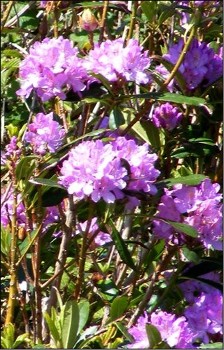A plan to sort out problem ponticums and other non-native trouble-makers: 2nd draft
Posted: Friday 2 October, 2009 @ 14:33:30

People living within and visiting Wester Ross in May and June will be familiar with ‘magnificent’ displays of blooming Rhododendron ponticum. Unfortunately, R. ponticum is an invasive non-native species (INNS) which has spread from gardens and is outcompeting native plants to the detriment of local wildlife and, where river banks are affected, fish populations. Many tens of thousands of pounds have already been spent within the area attempting to control this problem plant. Other problem invasive species include Japanese knotweed and North American mink.
The Wester Ross & Lochalsh Biosecurity Management Plan will be one of a set of 20 biosecurity plans being produced throughout Scotland as part of a national programme of action implemented through the Rivers and Fisheries Trusts of Scotland (RAFTS) with backing and support from the Scottish Government, Scottish Natural Heritage, Scottish Environment Protection Agency, and the Esmeé Fairbairn Foundation. WRFT recognises that there is already much on-going effort to control INNS within the area. The Trust will work as closely as possible with Skye and Lochalsh Environment Forum (SLEF), Wester Ross Environment Network (WREN), The Highlands Invasive Species Forum (HISF) the National Trust for Scotland (NTS) to develop a strategic plan which supports on-going efforts.
The vision of this plan is: ‘To establish a sustainable framework that will lead to the prevention, detection, control and eradication of invasive non-native species within Wester Ross and adjacent areas. This will be undertaken through the application of appropriate management activities, data collection, liaison, education and legislation ’
This vision will be achieved through the realisation of three objectives:
- Objective 1: Prevent the introduction and spread of new invasive non-native species and fish diseases within the Wester Ross area;
- Objective 2: Establish optimum surveillance, detection, monitoring and rapid response systems for the identified invasive non-native species and fish diseases which pose significant threats to local biodiversity and economy;
- Objective 3: Effective control and eradication programmes for existing invasive non-native species and fish diseases are operational and sustainable.
This draft biosecurity plan is a platform for local action to address those biosecurity issues. Please click here or go to the downloads page to view the intitial draft [ps. replaced by second draft in November 2009].
The plan aims to build and strengthen partnerships of differing groups of stakeholders to implement the actions required to address the complex issues associated with biosecurity. Outcomes and impacts will be reviewed and incorporated in the next generation plan as part of an adaptive management cycle its.
Please contact WRFT biologist with comments, any related information and suggestions for priority actions.
Related Links:
Highland Invasive Species Forum